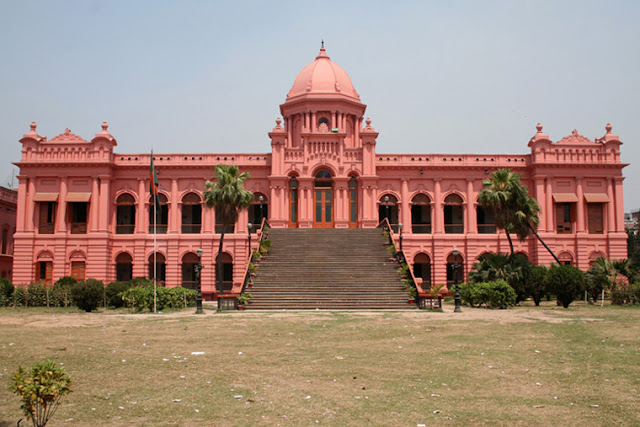The Ahsan Manjil

The Ahsan Manjil
On the bank of river Buriganga in Dhaka the pink majestic Ahsan Manzil has been renovated and turned into a museum recently.
|
|
It is an epitome of the nations rich cultural heritage. It is the home
of the Nawab of Dhaka and a silent spectator to many events.Todays
renovated Ahsan Manzil is a monument of immense historical beauty.
It has 31 rooms with a huge dome atop which can be seen from miles
around. It now has 24 galleries in 31 rooms displaying portraits,
furniture and household articles and utensils used by the Nawab.
The
making of Ahsan Manzil
In mughal period, there was a summer
house of Sheikh Enayet Ullah, the landlord of Jamalpur porgona (district), in
this place. Sheikh Enayet Ullah was a very charming person. He aquired a very
big area in Kumartuli and included in his summer house. Here he built a
beautiful palace and named it “Rangmahal”. He used to enjoy here keeping gorgeous
girls collecting from the country and abroad, dressing them with gorgeous
dresses and expensive ornaments. There is a saying that, the foujdar of Dhaka
(representative of mughal emperor) in that time was attracted to one of the
beautiful girls among them. He invited Sheikh Enayet Ullah in a party one night
and killed him in a conspiracy when he was returning home. That girl also
committed suicide in anger and sorrow. There was a one doomed cemetery of
Sheikh Enayet Ullah in the north-east corner of the palace yard, which was
ruined in the beginning of 20th century.
Probably in the period of Nawab
Alibardi Khan around 1740 A.D., Sheikh Moti Ullah, the son of Sheikh Enayet
Ullah, sold the property to the french traders. There was a french trading
house beside this property. The trading house became wealthier after purchasing
this property. In that time, french traders could do business here without
paying any taxes by a decree from the emperor Awrangajeb.
In that time, the French became very
wealthy doing business here in competition with the English and other Europian
companies. They made a big palace and dug a pond for sweet water in the
newly purchased property. The pond still exists in the compound of Ahsan
Manzil, which was called “Les Jalla” in that time. In the English-French war,
French got defeated and all their properties was captured by the English. In
the 22nd June of 1757, the French left the trading house with a fleet of 35
boats from the river station of Buriganga in Kumartuli.
n 1785, the English transferred the property to a French tradesman named Mr.
Champigni, and retaken it at 1801. According to Paris agreement of 1814, the
French claimed all their left properties at Dhaka, and in 1827 the property was
again returned to the French. For the increasing power of the English, the
French was forced to left subcontinent. They decided to sell all their
properties in Dhaka. So in 1830, the trading house of Kumartuli was purchased
by the established landlord of Dhaka Khwaja Alimullah.After some renovation work, the trading house became the residence of Khwaja Alimullah. In his time, a stable and a family mosque was added in the compound. After his death, his son Khwaja Abdul Gani made a great prosper to the property, and named it “Ahsan Manzil” on his son Ahsan Ullah. In the east side of the old building, he made a new building with a different design, and also done great renovation work to the old building. Since than, the old building was called “Ondor Mohol” and the new building was called “Rong mohol”. Visiting Hours of Ahsan ManzilApril-September:
October-March:
Entrance fee of Ahsan Manzil
|
|
কোন মন্তব্য নেই:
একটি মন্তব্য পোস্ট করুন